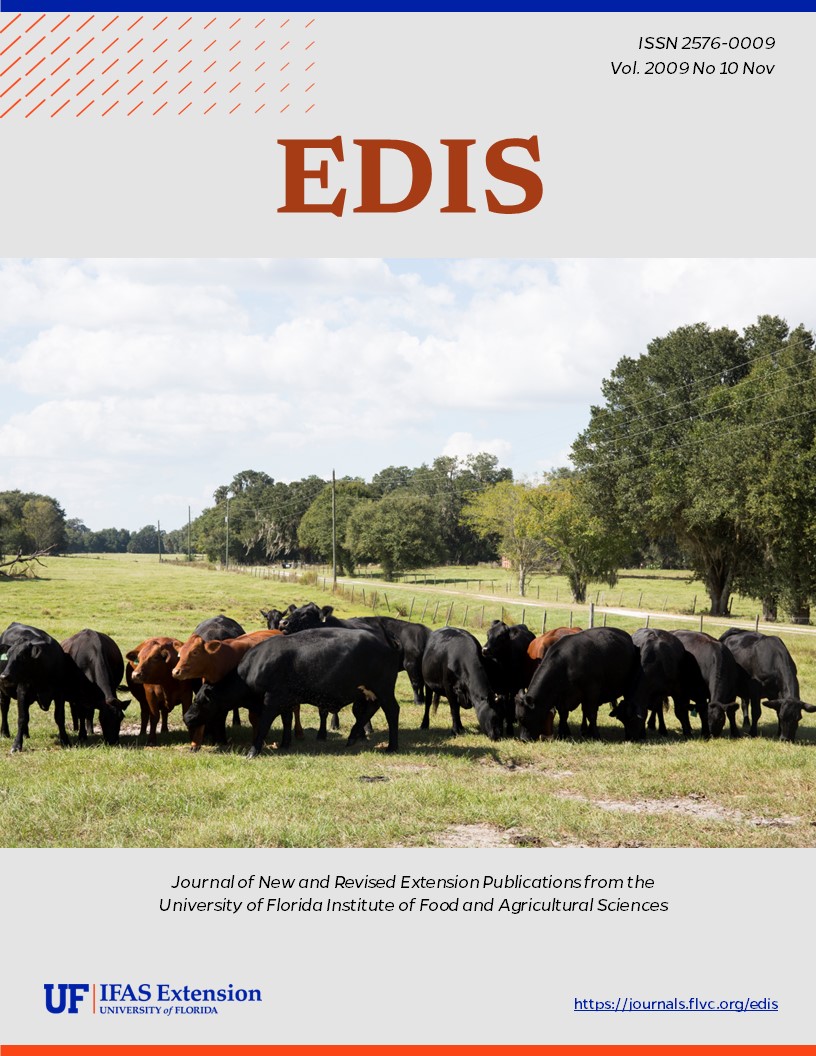Abstract
AN222, a 4-page fact sheet by Larry Eubanks, Chad Carr, and Chris Pantaleo, presents the results of a study to determine the growth of generic E. coli and aerobic bacteria as indicators of pathogenic bacteria on beef muscle held at 50°F for eight hours. Includes references. Published by the UF Department of Animal Sciences, November 2009.
References
Beef Industry Food Safety Council. 2003a. Best Practices for Beef Slaughter. Supported by National Meat Association, Southwest Meat Association, American Meat Institute and National Cattlemen's Beef Association. Centennial, Colo. Accessed August 4, 2009. http://nationaladmin.beef.org/CMDocs/BIFSCO/BestPracslaught07_09.pdf
Beef Industry Food Safety Council. 2003b. Best Practices for Raw Ground Beef Products. Supported by National Meat Association, Southwest Meat Association, American Meat Institute and National Cattlemen's Beef Association. Centennial, Colo. Accessed August 4, 2009. http://www.bifsco.org/CMDocs/BIFSCO/Best%20Practices/groundproducts2933.pdf
Beef Industry Food Safety Council. 2006. Best Practices for Non-Intact Beef Products. Supported by National Meat Association, Southwest Meat Association, American Meat Institute and National Cattlemen's Beef Association. Centennial, Colo. Accessed August 4, 2009. http://www.bifsco.org/CMDocs/BIFSCO/Best%20Practices/03_29_06non intactbestpractices.pdf
FDA. 2001. Factors that influence microbial growth. Washington D.C. Accessed August 4, 2009. http://wwwfdagov/Food/ScienceResearch/ResearchAreas/SafePracticesforFoodProcesses/ucm094145.htm
Ingham, S.C., R.K. Wadhera, M.A. Fanslau, and D.R. Buege. 2005. Research Note: Growth of Salmonella serovars, Escherichia coli O157:H7, and Staphylococcus aureus during thawing of whole chicken and retail ground beef portions at 22 and 30°C. J. Food Protection 68:1457-1461. https://doi.org/10.4315/0362-028X-68.7.1457
Ingham S.C., B.H. Ingham, D. Borneman, E. Jaussaud, E.L. Schoeller, N. Hoftiezer, L. Schwartzburg, G.M. Burnham, and J.P. Norback. 2007. Predicting pathogen growth during short-term temperature abuse of raw pork, beef, and poultry products: use of an isothermal-based predictive tool. J. Food Protection 70:1445-1456. https://doi.org/10.4315/0362-028X-70.6.1446
International Commission on Microbiological Specification for Foods. 1996. Microorganisms in foods. Roberts, T. A., A.C. Baird-Parker, and R.B Tompkin, editors. Volume 5, Characteristics of microbial pathogens. London: Blackie Academic & Professional. p 513.
Koohmaraie, M., T.M. Arthur, J.M. Bosilevac, M. Guerini, S.D. Shackelford, and T.L. Wheeler. 2005. Post-harvest interventions to reduce/eliminate pathogens in beef. Meat Sci. 71: 79-91. https://doi.org/10.1016/j.meatsci.2005.03.012
Loneragan, G.H. and M.M. Brashears. 2005. Pre-harvest interventions to reduce carriage of E. coli O157 by harvest-ready feedlot cattle. Meat Sci. 71: 72-78. https://doi.org/10.1016/j.meatsci.2005.04.005
Venkitanarayanan, K.S. and M. P. Doyle 2007. Foods Handbook of Nutrition and Food- Chapter 2- Microbiological Safety of Food. pp 38-43. https://doi.org/10.1201/b15294-5

